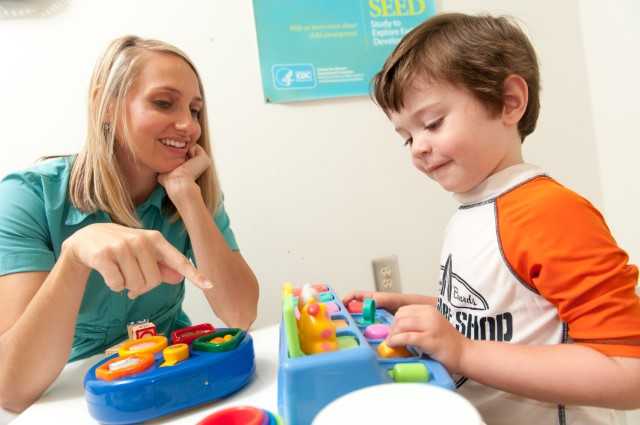Key Findings: Using standardized diagnostic instruments to classify children with autism to help find causes of the disorder

The Journal of Autism and Developmental Disorders has published a new analysis looking at how children are classified with autism spectrum disorder (ASD) in CDC’s Study to Explore Early Development (SEED). ASD is diagnosed by experienced clinicians (for example, developmental pediatricians and child psychologists) who conduct a thorough review of a child’s behavior and development. This thorough review often takes into account the results of standardized tools – such as observations and interviews – that offer a uniform way to define behaviors. This approach for diagnosing ASD, also known as clinical judgment, is considered the “gold standard” in ASD classification. In the new published analysis, CDC researchers developed a method for classifying children with ASD that relies on standardized diagnostic tools – a parent interview and clinical observation of the child – that can be used to create well-defined groups of children to help guide treatment decisions or research designs. CDC researchers examined how well this method for classifying children with ASD compared with the clinical judgment “gold standard.”
The method used by CDC researchers to classify children with ASD matches well with clinical judgment and identifies a diverse range of children with ASD. CDC’s method also provides guidance on how to resolve differences between parent report and clinical observation and how to interpret some parent-reported ASD symptoms in young children. Lastly, CDC’s method allows researchers to place children into different subgroups which can, in turn, improve our ability to learn more about the similarities and differences between children with ASD. These findings are important for researchers as they look for effective ways to classify children with ASD, particularly in studies looking at causes of the disorder.
You can read the abstract of the article here. Read more below for a summary of findings from this article.
Main Findings:
- Thus far, over 2,600 children enrolled in SEED completed a clinic visit and were classified as having ASD or not having ASD. The SEED method classified more than 700 children with ASD based on a combination of symptoms reported by the parent on the Autism Diagnostic Interview-Revised (ADI-R) and observed by a clinician on the Autism Diagnostic Observation Schedule (ADOS), which are the best diagnostic tools available for ASD.
- The way children were classified with ASD in SEED has several advantages compared to other classification methods. For example, the SEED method:
- Had a good balance of sensitivity (meaning children with ASD were correctly identified as having the condition) and specificity (meaning children without ASD were correctly identified as not having the condition);
- Allowed researchers to create well-defined groups of children who may experience different symptoms or who may develop in different ways;
- Identified more children with ASD, including children with very low mental age; and
- Offered ways to resolve differences between parent report of symptoms and clinical observation of symptoms.
- Overall, the findings support the use of the SEED method for classifying children with ASD when creating well-defined groups of children, which can be important for guiding the treatment process or research design.
- Researchers can use the SEED classification method to learn more about ASD and its complex causes and associated symptoms to help children and families.
About This Analysis
SEED is the largest research study in the United States to help identify factors that may put children at risk for ASD. The goals of this analysis were to
- Describe how children are classified with ASD in SEED using standardized diagnostic instruments,
- Determine whether certain ASD symptoms are reported by parents when a clinical observation indicates ASD but parent report does not indicate ASD, and
- Examine whether the SEED method accurately identifies children with and without ASD.
More Information
- CDC’s Study to Explore Early Development: www.cdc.gov/SEED
- An in-depth look at the scientific methods used in CDC’s Study to Explore Early Development: http://www.ncbi.nlm.nih.gov/pubmed/22350336
- Screening and diagnosis for autism spectrum disorder: https://www.cdc.gov/ncbddd/autism/screening.html
Key Findings Reference
Wiggins LD, Reynolds A, Rice CE, Moody EJ, Bernal P, Blaskey L, Rosenberg SA, Lee LC, Levy SE. Using standardized diagnostic instruments to classify children with autism in the Study to Explore Early Development. Journal of Autism and Developmental Disorders. 2014 [epub ahead of print].
E-mail Your Friends
"Children with autism spectrum disorder are not being diagnosed as early as they could be. Learn the signs of autism and get help if you’re concerned."
Share on Facebook

“Many children with autism spectrum disorder (ASD) are not being identified as early as they could be. Early identification is the most powerful tool we have right now to make a difference in the lives of children with ASD.”
Share on Twitter
“Too many children w/ autism are not being identified as early as they could be. Earlier is better. #ActEarly”
- Page last reviewed: April 28, 2017
- Page last updated: October 27, 2014
- Content source:


 ShareCompartir
ShareCompartir